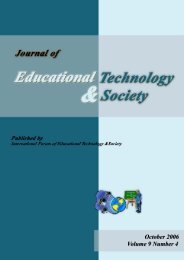Student Engagement: What do we know and what should we do?
Student Engagement: What do we know and what should we do?
Student Engagement: What do we know and what should we do?
Create successful ePaper yourself
Turn your PDF publications into a flip-book with our unique Google optimized e-Paper software.
When student engagement first emerged in the late 1980’s, researchers tended to<br />
view its “causes” almost exclusively through the lens of a set of demographic <strong>and</strong><br />
social risk factors attributed to individual students (e.g. family circumstances,<br />
influence of peers). Over time, ho<strong>we</strong>ver, the concept <strong>and</strong> its measures began to<br />
shift in meaning as a result of increased attention to the influence of school<br />
context, particularly the relationships bet<strong>we</strong>en school climate <strong>and</strong> students’<br />
experience of engagement (Dunleavy & Milton, 2009, p. 7).<br />
Research into the impact that levels of participation <strong>and</strong> senses of belonging have on<br />
learning continue, as seen in studies by Dunleavy & Milton (2009) <strong>and</strong> Willms, Friesen,<br />
& Milton (2009), <strong>and</strong> appears to complement academic engagement or achievement<br />
strategies.<br />
To establish better classroom management<br />
Throughout the 1990’s, as research on disengagement <strong>and</strong> disruption in classrooms was<br />
on the rise, student engagement also became useful for gaining compliance or control of<br />
an increasingly restless <strong>and</strong> diverse student population. As an everyday classroom<br />
management strategy, teachers could use various teaching strategies (differentiated<br />
learning) to engage students in their work – such as group work, Po<strong>we</strong>rPoint or<br />
multimedia presentations of topics, <strong>and</strong> project-based learning. As an aside, research into<br />
ways of reaching disengaged students <strong>and</strong> garnering their interest in focusing on topics<br />
instead of classroom misbehavior resulted in a surge of beneficial theories <strong>and</strong><br />
applications around “differentiated learning.”<br />
“Disengagement has been cited as a major cause of deviant behavior at school,<br />
truanting, <strong>and</strong> low academic achievement. (Carrington, 2002; Lamb, Walstab, Tesse,<br />
Vickers, & Rumberger, 2004) as cited in Harris, 2008, p. 57).<br />
Although moving away from board <strong>and</strong> book learning <strong>and</strong> into more “fun” <strong>and</strong><br />
interesting activities helped engage students <strong>and</strong> reduce behavioral problems in<br />
classrooms, the purpose of student engagement was still to reactively fix a problem <strong>and</strong><br />
its goal was still to have all students <strong>do</strong>ing <strong>what</strong> <strong>we</strong> wanted them to <strong>do</strong>, learning <strong>what</strong> <strong>we</strong><br />
wanted them to learn, but adding some variations to how they learned it. The curriculum<br />
remained roughly the same – in content, process, <strong>and</strong> form of evaluation. The teacher was<br />
still expert in charge, using a few extra new tools, <strong>and</strong> the students follo<strong>we</strong>d along as best<br />
they could.<br />
During this time, the research suggests that <strong>we</strong> started to pay attention to whether<br />
students not only passed <strong>and</strong> participated but also enjoyed their learning experiences.<br />
Shernoff, Csikszentmihalyi, Schneider, & Shernoff (2003) in their study on optimal states<br />
of learning found that many students <strong>we</strong>re achieving academically <strong>and</strong> perhaps even<br />
participating in some activities, but <strong>we</strong>re still disengaged in learning. They report, “Even<br />
among students who finish the required years of schooling … research has found high<br />
rates of bore<strong>do</strong>m, alienation, <strong>and</strong> disconnection from schooling (Larson & Richards,<br />
<strong>Student</strong> <strong>Engagement</strong>: <strong>What</strong> <strong>do</strong> <strong>we</strong> <strong>know</strong> <strong>and</strong> <strong>what</strong> <strong>should</strong> <strong>we</strong> <strong>do</strong>? 11












